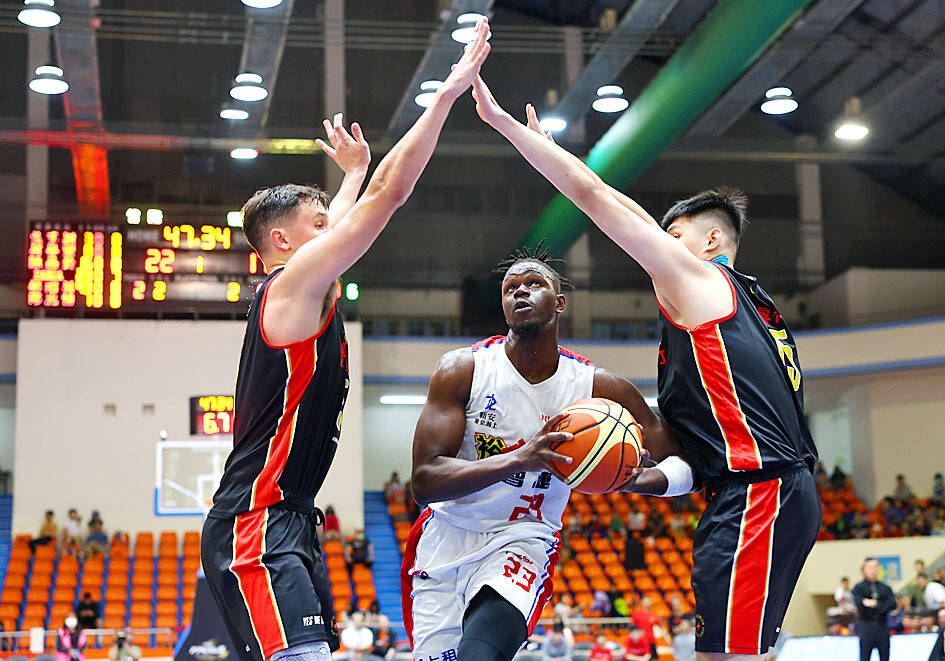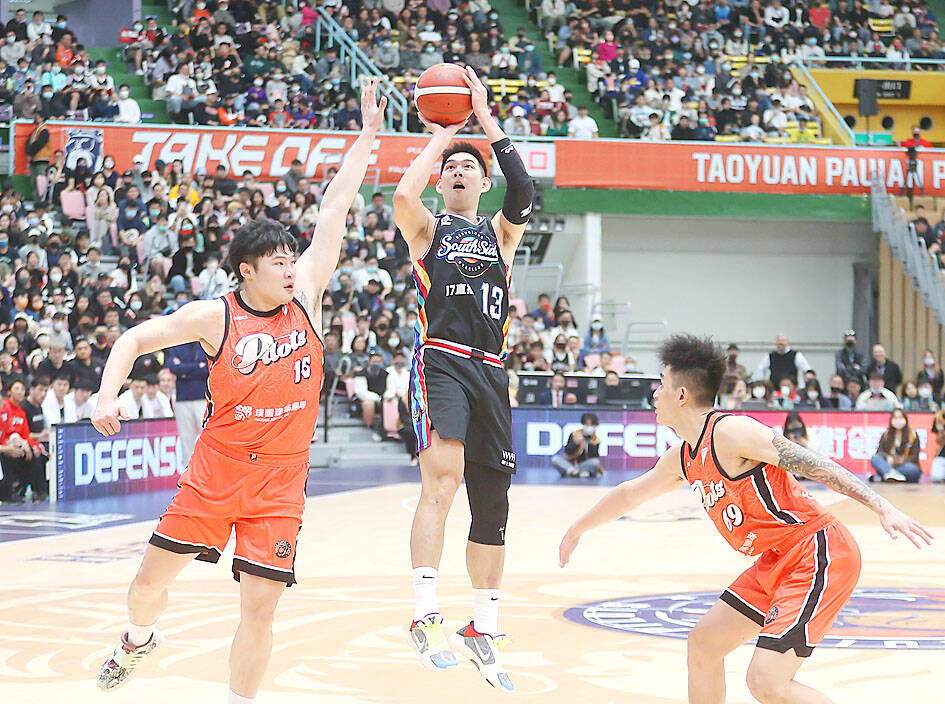Twenty years after Michael Lewis uncovered the magic behind the Oakland Athletics’ 2002 season in his bestseller Moneyball, analytics have greatly changed the landscape of US sports for teams and fans.
However, in Taiwan, advanced basketball stats such as player efficiency ratings (PER), win shares and points per possession (PPP) have yet to make an impact.
Data analysis company GC.Basket is hoping to change that.

Photo: CNA
“What we want to do is to revolutionize basketball in Taiwan with analytics,” GC.Basket cofounder Ko Huan-wei told reporters, while acknowledging that obstacles exist, including the generally conservative nature of Taiwanese basketball coaches.
To many of them, data do little more than confirm what they see on game tapes, but Ko, a data analyst for the Taoyuan Pauian Pilots in the P.League+, sees analytics as an ideal complement to video.
“We always watch the games first to get a general idea of what happened, but impressions can be wrong,” Ko said. “Analytics can find problems and quantify them and help us make better decisions.”

Photo: CNA
In some ways the Pilots mirror the A’s, lacking the resources and talent of better-financed P.League+ teams, but their league-record 10-game winning streak earlier this season showed how analytics can help level the playing field.
Most P.League+ teams start two foreign players because they tend to be better individually than local players, but Ko’s numbers found the Pilots to be more efficient on defense with one imported player instead of two.
Those metrics were used by Pilots head coach Iurgi Caminos to deploy the most advantageous combinations and were an unsung hero in the Pilots’ win streak while starting only one foreign player.
However, Ko wants to do more than simply affect how one team plays the game. He dreams of building an analytics framework that elevates the overall level of play and helps Taiwan catch up with other countries on the floor.
After getting a master’s in environmental engineering at Temple University in Philadelphia, Pennsylvania, in 2018, Ko learned basketball analytics from coach Riley Yang at Fu Jen Catholic University in New Taipei City for a year.
The two then set out to design an online basketball analytics system first modeled on the NBA and later modified to meet local demand.
Ko said that following the NBA’s advanced metrics proved impractical because GC.Basket’s resources paled in comparison to those invested in statistics by the NBA.
“Actually, the data GC is providing are more than sufficient for our clients right now,” Ko said. “We’re working on optimizing how the data are presented and deployed, and deepening the connection between data and the clubs and fans. We think this is what’s needed now rather than just aimlessly pursuing different kinds of statistics.”
The system’s data are obtained by having GC.Basket staffers watch games and fill out game logs, which are used to generate advanced metrics such as PER, PPP and defensive deflections — how often a player disrupts an offensive possession or forces a turnover, directly or indirectly.
The system also tracks player combinations. Kaohsiung Steelers’ sharpshooter Lu Cheng-ju, for example, is much better from three-point range when teammate Jeremy Lin is on the floor (37 percent shooting percentage) than when Lin is not (28 percent).
Thanks to the system, a basketball amateur like Ko was able to analyze games professionally, earning him a job as an assistant coach with Pauian’s club in the semi-professional Super Basketball League (SBL) in 2020, before being promoted to the Pilots as the team’s data analyst in 2021.
GC.Basket has started collecting game data from Taiwan’s University Basketball Association, the Women’s Super Basketball League, the P.League+ and the T1 League since the company formed at the end of last year.
Beyond offering the full database to its clients — such as local pro teams and sports agencies — GC.Basket makes part of its database available to the public for free on its Web site, and some P.League+ broadcasters have used the numbers to give their commentary added depth.
That is a necessary step if Taiwan wants to professionalize and commercialize basketball, Ko said.
“A comprehensive database of videos and spreadsheets is the key to the NBA’s commercial success. It makes it possible to dig out records and stories to promote the league at any time, and is something Taiwan should emulate,” Ko said.
Former GC.Basket partner Jack Yu, a pro basketball trainer in Taiwan, sees the system as a means to preserve Taiwan’s basketball history.
“We can only hear about how good Taiwanese players used to be because we don’t have much data from their games,” Yu told reporters.
With the GC.Basket database, “we’ll be able to see how players did even after several decades,” he said.
The slow embrace of basketball analytics in Taiwan might be rooted in its lack of experts with related know-how.
No team in the SBL had a data analyst until the Pauian Archiland hired Ben Metcalf, a former Orlando Magic scout, in 2010.
Today, the Taipei Fubon Braves (Lin Wei-hao) and the New Taipei Kings (James Lin) in the P.League+ and the Kaohsiung Aquas (Peng Te-hsuan) in the T1 League have data specialists, but James Lin said that was still not enough.
“The fact that local franchises have only one or none suggests that basketball analytics in Taiwan still have a long way to go,” he told reporters.
Analytics can be easily overlooked because games are decided by so many factors, he said.
For the value of analysts’ work to be recognized in Taiwan, “we have to help our teams win games first,” he said.
The biggest supporter of data in the pros is Roger Hsu, head coach of the Braves, who are two-time P.League+ defending champions.
He was helped by Metcalf when he coached Pauian’s SBL team and had Metcalf join his coaching staff soon afterward, helping Pauian to four straight SBL titles from 2012 to 2015.
Describing analytics as “a scientific approach that can help coaches spot problems and players improve,” Hsu told reporters that it can give local coaches “a very different perspective” and lead to different training methods rather than sticking to outdated routines.
For now, GC.Basket is less focused on catering to fans as it builds a business, but Ko said that the firm is developing games to start familiarizing fans with advanced stats.
It rolled out a Taiwan version of a fantasy game on a trial basis that featured P.League+ players and received positive feedback, Ko said, adding that the firm is hoping to come up with other ways to foster fan interest in data.
It is hard to tell how far basketball analytics can go in Taiwan, but GC.Basket’s presence suggests that the journey has at least begun.
“That we’re talking about them [GC.Basket] now proves they’re already heading to success,” Yu said. “Let’s be patient and give them some time.”

Bologna on Thursday advanced past Empoli to reach their first Coppa Italia final in more than half a century. Thijs Dallinga’s 87th-minute header earned Bologna a 2-1 win and his side advanced 5-1 on aggregate. Giovanni Fabbian opened the scoring for Bologna with a header seven minutes in. Then Viktor Kovalenko equalized for Empoli in the 30th minute by turning in a rebound to finish off a counterattack. Bologna won the first leg 3-0. In the May 14 final in Rome, Bologna are to face AC Milan, who eliminated city rivals Inter 4-1 on aggregate following a 3-0 win on Wednesday. Bologna last reached the

If the Wild finally break through and win their first playoff series in a decade, Minnesota’s top line likely will be the reason. They were all over the Golden Knights through the first two games of their NHL Western Conference quarter-finals series, which was 1-1 going back to Minnesota for Game 3 today. The Wild tied the series with a 5-2 win on Tuesday. Matt Boldy had three goals and an assist in the first two games, while Kirill Kaprizov produced two goals and three assists. Joel Eriksson Ek, who centers the line, has yet to get on the scoresheet. “I think the biggest

From a commemorative jersey to a stadium in his name, Argentine soccer organizers are planning a slew of tributes to their late “Captain” Pope Francis, eulogized as the ultimate team player. Tributes to the Argentine pontiff, a lifelong lover of the game, who died on Monday at the age of 88, have been peppered with soccer metaphors in his homeland. “Francisco. What a player,” the Argentine Football Federation (AFA) said, describing the first pope from Latin America and the southern hemisphere as a generational talent who “never hogged the ball” and who showed the world “the importance of having an Argentine captain,

Noelvi Marte on Sunday had seven RBIs and hit his first career grand slam with a drive off infielder Jorge Mateo, while Austin Wynn had a career-high six RBIs as the Cincinnati Reds scored their most runs in 26 years in a 24-2 rout of the Baltimore Orioles. Marte finished with five hits, including his eighth-inning homer off Mateo. Wynn hit a three-run homer in the ninth off catcher Gary Sanchez. Cincinnati scored its most runs since a 24-12 win against the Colorado Rockies on May 19, 1999, and finished with 25 hits. Baltimore allowed its most runs since a 30-3 loss to